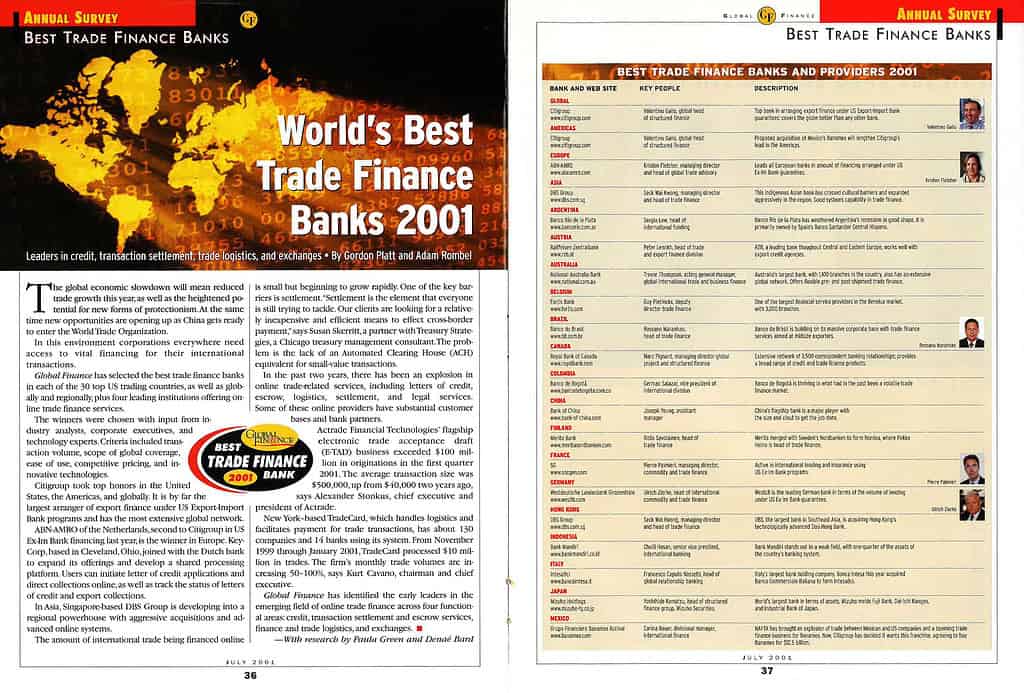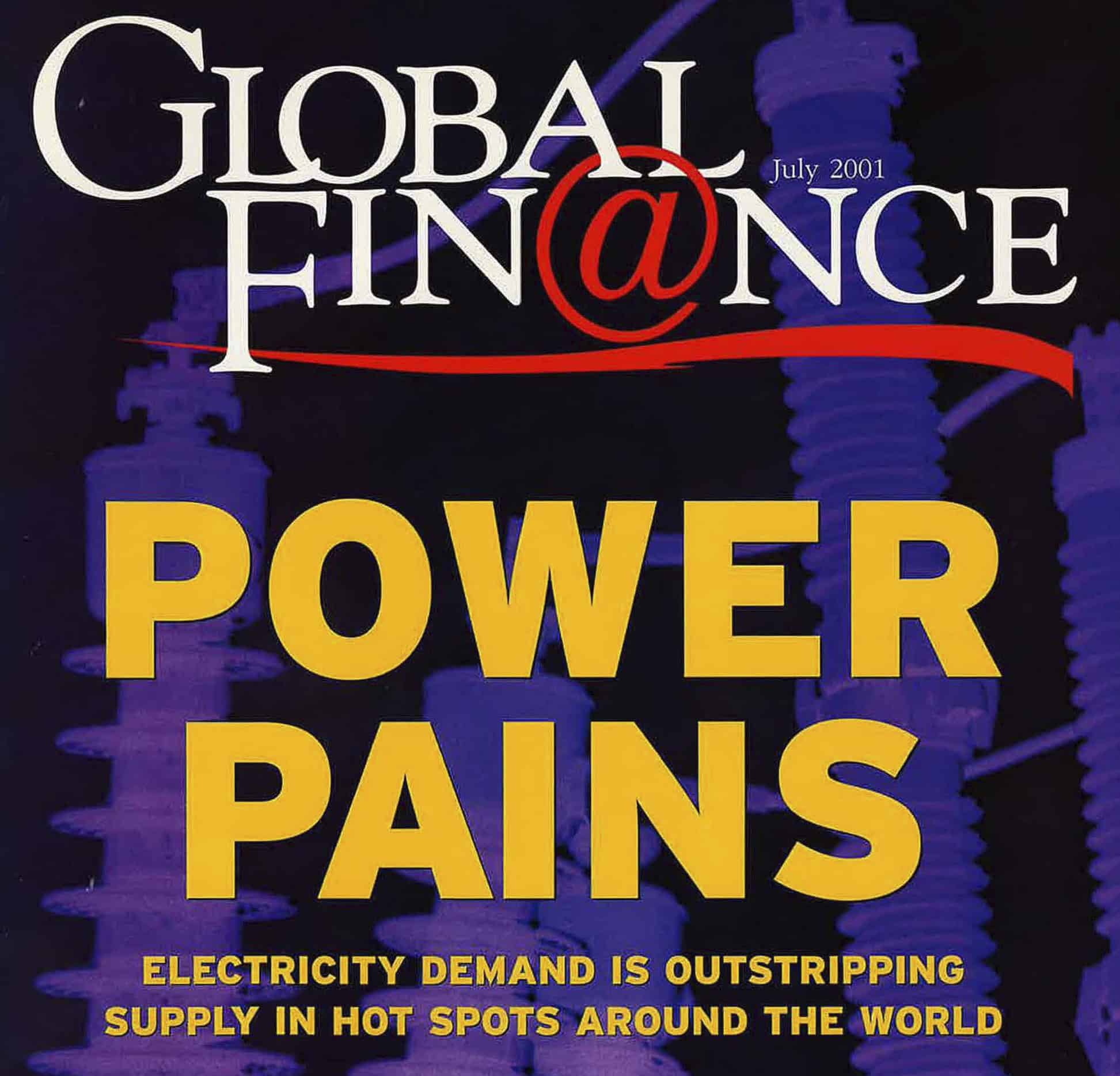In hindsight, summer 2001 was a precarious time to launch an annual ranking of the world’s Best Trade Finance Banks. Just months later, the 9/11 attacks would destroy New York’s World Trade Center, triggering a global economic slowdown. Air travel ground to a halt, ports closed, and borders tightened—bringing international trade to a near standstill.
The organizations covered in Global Finance’s first listing would face economic upheavals in the coming decades: among them, the 2008 global financial crisis, the European sovereign debt crisis, the 2015 Chinese stock market crash, and the Covid pandemic. As illustrated by the organizations appearing in Global Finance’s 25th edition of this listing, however, trade finance banking has survived these crises and thrived.
Since our initial awards, trade barriers have fallen worldwide. In 2001, China entered the World Trade Organization while the EU minted multiple free trade agreements. Asia’s Regional Comprehensive Economic Partnership was signed in 2020. The African Continental Free Trade Area was instituted the following year. These and other international agreements typically reduce tariffs and improve global business.
But global trade remains a complex process, further complicated by a host of laws and regulations. These include managing tariffs, quotas, and customs; complying with import and export laws; determining and paying appropriate taxes; and adhering to sanctions and embargoes. Paperwork abounds.
Since 2001, paper-based documentation, including letters of credit and bills of lading, has been digitized. Electronic documents, e-voicing, and trade portals all shorten transaction times and reduce instances of human error. Artificial intelligence and automation streamline document verification, compliance checks, and risk assessment. Distributed ledger technologies help reduce fraud. And the Internet of Things tracks goods in real time, providing vital insight into the supply chain.
Award Winners Evolve With The Market
Global Finance’s Best Trade Finance Banks award winners have excelled in cross-border financing, notably supply-chain financing, financing in emerging markets, and technology adoption.
The awards program initially focused on banks operating in 30 countries and regions, which Global Finance understood were undergoing a period of technological change. “The amount of international trade being financed online is small but beginning to grow rapidly,” we reported in 2001.
That year, Citigroup took top honors in the US, the Americas, and the world. Global Finance called it the “largest arranger of export finance under US Export-Import Bank [EXIM] programs” and hailed its “expansive global network.” Asia-regional winner DBS was “developing into a regional powerhouse”; it is now one of Asia’s largest banks.
Citigroup took similar awards in 2002 and 2003. In 2004, Global Finance highlighted the work of the bank’s Banamex subsidiary, which had financed Aeroméxico’s purchase of spare parts and maintenance services. This was the first Mexican peso-dominated financing supported by EXIM, we noted. Citi’s support for credit-guarantee facility transactions in local currency attracted widespread recognition in the Mexican business community.

International trade cooperation would only grow. In 2005, Deutsche Bank closed a $100 million syndicated insured receivables purchase facility for Sadia, a leading Brazilian producer of poultry, meats, and processed foods.
“In a display of German financial engineering, Deutsche Bank acted as lead arranger and agent for the complex facility, which brought together 16 European and Latin American banks as buyers of Sadia’s export receivables,” we reported. The deal earned Deutsche Bank the country award for Germany.
By 2006, new supply chains linking mass retailers with overseas suppliers challenged trade finance banks to devise new ways of doing business. Global Finance lauded ABN Amro for confirming a letter of credit from Karachi-based Metropolitan Bank to import canola into Pakistan. In confirming the letter of credit, the Dutch bank obligated itself to pay suppliers once appropriate documents were presented as evidence of the delivery of goods. This was the first transaction completed under the International Finance Corporation’s Global Trade Finance Program.
By the following year, trade bankers were playing an increasingly sophisticated role in keeping global supply chains running smoothly. Most notably, they steadily increased the capital available to suppliers in emerging markets. BNP Paribas, for example, was lauded for providing “a wide range of international guarantees.”
Weathering The Global Credit Crisis
Following the Lehman Brothers collapse in 2008 and the ensuing global credit crisis, international trade declined in 2009 for the first time in 27 years. No longer was credit a commodity available at an affordable price, as needed, as trade banks grew more cautious. Yet, some forward-thinking institutions expanded their business into emerging markets. Standard Chartered acquired banks in Thailand, South Korea, Indonesia, Taiwan, and other countries, earning it a regional award for its work in Asia.
Global trade began to rebound in 2010. Major trade banks worked with export credit agencies and multilateral institutions to develop financial products that lowered risk, restored trust, and accelerated cash flows.
Two years later, Global Finance was examining banks in 78 countries and regions, even as the European sovereign debt crisis sparked fears of a retraction in global trade. Many European banks withdrew credit from Asia, now an important manufacturing region. After Basel III, some institutions, finding it difficult to meet international capital, liquidity requirements, and leverage caps, abandoned trade finance altogether. Those that held on faced increased scrutiny and passed on higher capital costs to their customers.
New regulations such as Basel III spurred a technological revolution as banks saw in new tech tools a way to do better business and satisfy regulators. SWIFT hastened payments by reducing the need for manual processing of trade documents while helping banks meet sanctions screening and AML/KYC requirements.
By 2018, new platforms were enhancing trade capabilities and streamlining back-office processing. Data and analytics looked to be a new source of value, particularly in predictive analytics. CCRManager, an internet platform that manages the distribution of trade finance assets amongst themselves, credit issuers, and fund managers, received our award for Best Trade Finance Infrastructure. With more than 14 million trade transactions annually, BNP Paribas won as Best Bank for Trade Finance.
Digitization was helping to close the trade gap between developed and developing countries. In 2019, Global Finance reported, “The leading trade finance banks are on the verge of transforming their industry … to a more efficient and transparent digitized model. This could help bankers amass the necessary resources to bridge the trade finance gap in emerging markets and, armed with transaction data, customize their trade offerings to better meet each customer’s needs.”
Covid intensified the digital transformation. In 2020 and 2021, corporates and banks struggled with liquidity issues and supply chain disruptions. Legacy platforms and processes created additional obstacles. But technology often furnished solutions.
Banks and other providers embraced digitization strategies and introduced efficiencies into their processes that ultimately lowered costs, helped them manage their balance sheets, and attracted new investors. Consider the overall 2021 winner, Citi. Its trade finance toolkit included applications that improved connectivity between trade finance partners.
New Storms, New Solutions
Global trade volume increased in 2022 and 2023 despite rising energy prices, inflation, surging interest rates, and the repercussions of the Russia-Ukraine war. The International Chamber of Commerce last year predicted an annual rise in global trade of 3.8% through 2032. Powering that growth are banks in more than 100 countries and regions examined by Global Finance for the 2025 Best Trade Finance Banks awards.
The horizon is not cloudless. Protectionism, including new and higher tariffs, may shut some international doors. Currency risks now require trade finance banks to develop hedging instruments to manage fluctuations in volatile markets.




